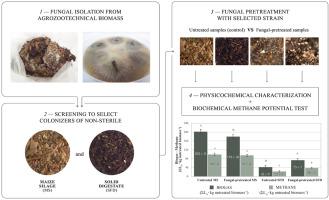Biomass & Bioenergy ( IF 5.8 ) Pub Date : 2020-12-16 , DOI: 10.1016/j.biombioe.2020.105934 Andrea Zanellati , Federica Spina , Anna Poli , Luca Rollé , Giovanna Cristina Varese , Elio Dinuccio

|
The enhancement of the yields of the anaerobic digestion process was the primary target of the present study, thanks to the development of an innovative fungal pretreatment. The fungal community of agrozootechnical biogas plant feedstocks and by-products (i.e., maize silage and stover, zootechnical slurry and manure, wheat and rice straw, and solid digestate) were studied, isolating and identifying 172 strains belonging to 89 taxa. The mycobiota was dependent on the biomass: maize and zootechnical samples showed a higher biodiversity than straw and solid digestate. During the preliminary screening, Cephalotrichum stemonitis extensively grew on both non-sterile maize silage and solid digestate and it was then selected for their pretreatment. The fungus did change the biomasses features: the total solids decreased (approximately 20%), while the volatile solids slightly changed (<1%). Lignin, cellulose and hemicellulose degradation rate in maize silage was higher (55.2%, 25.0% and 24.5%, respectively) than in solid digestate (8.7%, 0.6% and 10.9%, respectively), highlighting their different accessibility and recalcitrance. During the anaerobic digestion, fungal-pretreated maize silage produced lower cumulative biogas and methane than the control, probably due to an excessive degradation of easily accessible fibers. On the contrary, the pretreated solid digestate was less recalcitrant to the microbial transformation in the anaerobic digestion: as a result, cumulative biogas and methane yields were significantly enhanced (approximately 70%). By favoring the (re)use of digestate as a feedstock, the investigated fungal pretreatment could help the economic and environmental sustainability of the anaerobic digestion.
中文翻译:

使用从农业沼气厂中选出的头孢霉菌性中耳炎菌株对非灭菌玉米青贮饲料和固体消化物进行真菌预处理,以增强厌氧消化
由于创新的真菌预处理技术的发展,提高厌氧消化过程的产量是本研究的主要目标。研究了农业生物技术沼气厂原料和副产品(即玉米青贮饲料和秸秆,动物粪便和肥料,小麦和稻草以及固体消化物)的真菌群落,分离并鉴定了属于89个分类单元的172个菌株。真菌菌群取决于生物量:玉米和动物技术样品显示出比秸秆和固体消化物更高的生物多样性。在初步筛查中,头孢菌素性鼻炎在非无菌玉米青贮饲料和固体消化物上广泛生长,然后选择其进行预处理。真菌确实改变了生物量的特征:总固体减少(约20%),而挥发性固体略有改变(<1%)。玉米青贮饲料中木质素,纤维素和半纤维素的降解率(分别为55.2%,25.0%和24.5%)高于固体消化物中的木质素,纤维素和半纤维素的降解率(分别为8.7%,0.6%和10.9%),突出了它们的可及性和顽强性。在厌氧消化过程中,经过真菌预处理的玉米青贮饲料产生的累积沼气和甲烷含量低于对照,这可能是由于易于获取的纤维过度降解所致。相反,经过预处理的固体消化物在厌氧消化中对微生物转化的抵抗力较低:因此,累积的沼气和甲烷产量显着提高(约70%)。通过支持(再)利用消化物作为原料,所研究的真菌预处理可以帮助厌氧消化的经济和环境可持续性。











































 京公网安备 11010802027423号
京公网安备 11010802027423号